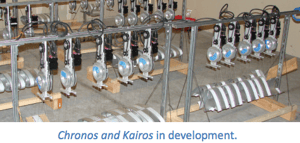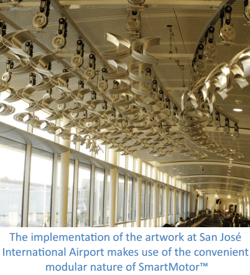SmartMotor Coordinates Multiple Axes
Coordinated motion of multiple axes is not a straightforward task. When the technology artists behind this motorized sculpture needed an integrated and effective way to choreograph the movement of 65 precisely engineered mechanisms, they recruited the help of Animatics' SmartMotor™ solution.

The robotic artwork, a collaboration between artists Banny Banerjee, Matt Gorbet, Susan LK Gorbet and Maggie Orth, executes complex and precise choreographed patterns of movement such as pulsing to simulate breathing, wave effects, and sequential movements. The 65 motors are networked together and are triggered with high-level commands sent over RS-232. When a motion command is sent, it is echoed from one motor to the next in each serial chain. There is less than one millisecond delay in these signals and no signal integrity is lost as the commands move down the chain so reliability is greatly improved.

SmartMotor™ servos can communicate via RS-232, RS-485, Profibus, Ethernet, and CAN buses all simultaneously. This communication flexibility offers a significant advantage and cost-effectiveness over traditional component-based motion systems. SmartMotor™ capabilities truly shine when high axis count coordinated motion is needed. Class 5 SmartMotor™ servos have the ability to have one or several masters within a network. With the new Combitronic™ communications over the CAN bus, a user may write one program in a motor that can monitor and alter other parameters and data in any other motor in the network in real time.
Field servicing a complex artwork on the ceiling at a functioning airport terminal would be an arduous task if the controllers weren’t integrated with the motors, as identification of the exact root cause of a problem could be difficult in such a high traffic area. Diagnostics are greatly simplified with the SmartMotor™ technology because each node becomes its own machine that can simply be swapped out in case of a failure. All of this translates to reduced MTBF (mean time between failure), and more time allowing your machine(s) to do what is needed. Chronos and Kairos was commissioned by the City of San José Public Art Program, and engineered and fabricated by Monkey Wrench Design of San Francisco
Download the PDF version of this case study here.








